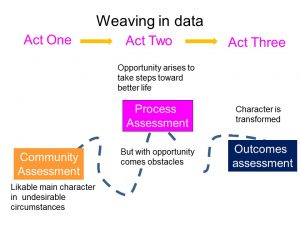Jun
21

Posted by nnlmneo on June 21st, 2017
Posted in: Blog

Once upon a time, there was an evaluator like any other. She often was called on to present evaluation results of special projects. Sometimes it was at the request of influential stakeholders. Other times, it was for colleagues at professional conferences. Almost always, she got the same audience response.
Zzzzzzzzzzzzzzzzzzzzzzz
Then one day, I realized the root cause of my dull presentations. It was the tortuous scientific reporting format that I learned in graduate school and continued to use in my professional life. I would start with background information, describe evaluation methods, read through a bullet-point list of findings, and squeeze in some conclusions in the remaining minutes of my allotted time slot. I always ran out of time because I never practiced. I never practiced because I was too bored to listen to myself.
Fortunately, I was one of many evaluators waking up to the ineffectiveness of our presentation styles. We were strangling the life out of the exciting projects and initiatives we helped to manage. Then one day, some savvy leaders in the evaluation field staged a profession-wide intervention and The American Evaluation Association’s Potent Presentation Initiative (p2i) was born. With p2i guidance, I developed my own formulas for evaluation presentations. I vary my structure based on the message I want to convey, but I use one format specifically for project evaluation presentations.
I tell fairy tales, only with real-life facts.
Advancing through Three Acts
In every fairy tale, the story unfolds in three acts. Act 1 is the setup. The audience first meets a hero who faces an undesirable situation. A good tale makes us like the hero and relate to his or her circumstances. The first act always concludes with an opportunity. This opportunity offers potential for payoff, but requires perseverance. There are no free lunches in fairy tales.
Act 2 describes the journey. It highlights key activities, but audience engagement is highest when the hero faces obstacles and finds ways to adapt. Failure, too, is compelling because the audience relates to pushing forward in the face of setbacks. Act 3 is about transformation: how all the characters change as a result of the journey.
This three-act structure serves the audience because they recognize it and experience the satisfaction of moving toward conclusion. It also serves the presenter, because the narrative structure helps you remember the facts you want to convey. Those facts are your evaluation findings.
Expanding with Evaluation Facts

Once you have your three acts, your evaluation findings are added to enhance the story. Every story weaves details into the plot to bring the experience alive in the listeners’ imagination. In Act 1, bring in demographics that describe your heroes, also known as program participants or beneficiaries. What illnesses prevail in their worlds? What challenges prevent them from managing their own or family members’ health? Are they health professionals with too many patients and not enough time and resources to treat them? Are they librarians lacking the proper technology or resources to provide assistance?
It’s important to present your heroes’ strengths as well as struggles. You are most likely to find these details in stakeholder or focus group interviews done during project planning. Interviews can provide quotes, allowing your heroes to describe their situations in their own voices.
The project team may or may not be part of the beneficiary community, but you are part of the journey. You should explain what you bring to the journey, and, in subsequent acts, your own experiences and transformation.
In Act 2, you can use your program deliverable statistics to describe the project-journey. Of course, you want to include metrics that demonstrate the extent of your efforts. Feedback from participants and others affected by the projects are also important elements. Remember, though, smooth sailing makes for an undramatic story. Don’t be afraid to show unimpressive findings. Just be sure to explain how you and the heroes altered course and adopted a more successful process.
Act 3 spotlights your outcomes. Talk about how your heroes’ lives became better as a result of your project. What useful knowledge have they gained? What will they do differently to improve their lives? How do the journey’s benefits reach through them into their communities or organizations? The program team’s lessons learned are also of interest. What did you learn that you can apply in future projects?
Of course, there’s always the possibility that your outcome metrics will fall short of expectations, particularly if you are talking about a pilot program. But learning always equals transformation. Explain what you now know about doing things differently in future programs? What unexpected outcomes can enlighten us all?
Telling fairy tales is much more fun and effective than “giving presentations.” If you are concerned that your buttoned-down audiences won’t respond to a fairy tale structure, don’t worry. They’ll never realize you’re telling a true-to-life fairy tale. They’ll just wonder why your presentation is easier to listen to than most.
Credit: I want to thank my story-telling teacher, Amanda Rountree, for teaching me the conce “advancing” and “enhancing” stories.